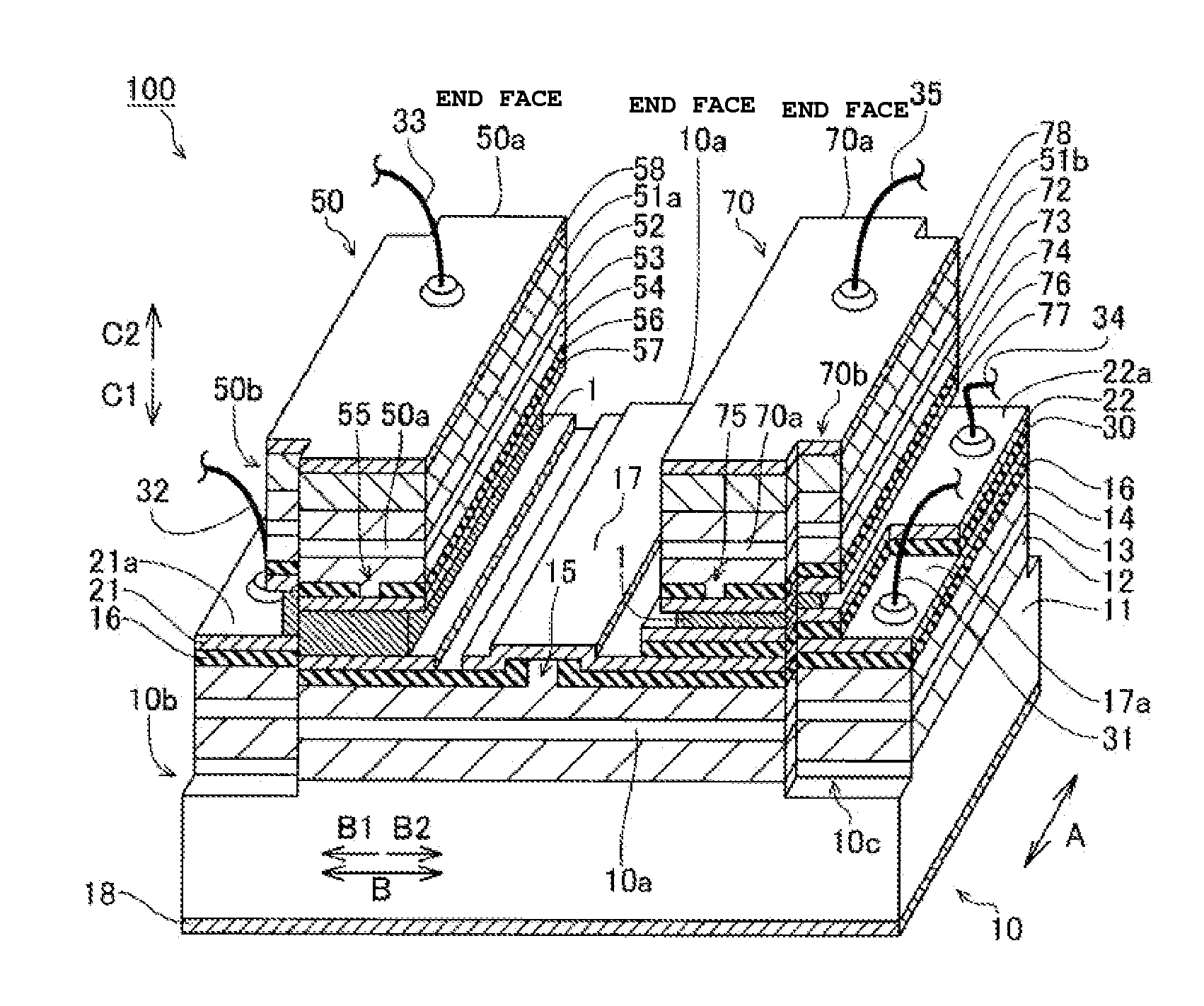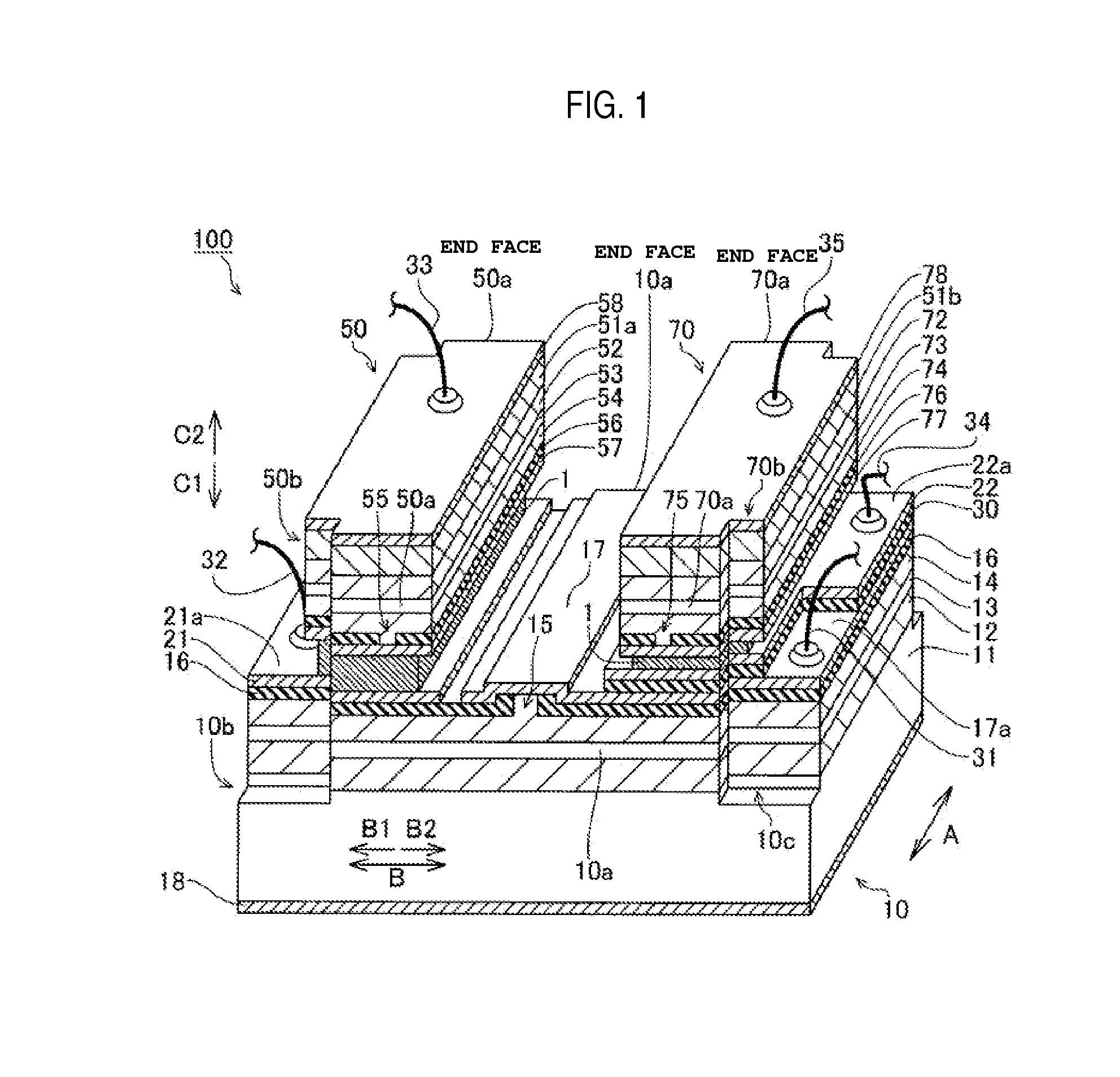Semiconductor laser device and manufacturing method thereof
- Summary
- Abstract
- Description
- Claims
- Application Information
AI Technical Summary
Benefits of technology
Problems solved by technology
Method used
Image
Examples
first embodiment
Modification of First Embodiment
[0087]FIG. 11 is a perspective view showing a structure of a two-wavelength semiconductor laser device according to a modification of the first embodiment. With reference to FIG. 11, in the modification of the first embodiment, a description is given of a case where two-wavelength semiconductor laser device 150 including two wavelength laser elements is formed by bonding red semiconductor laser element 50 to the upper surface of blue-violet semiconductor laser element 160. Note that, blue violet semiconductor laser element 160 is an example of a “first semiconductor laser element” of the invention, and the upper surface of blue-violet semiconductor laser element 160 is an example of the “first surface” of the invention.
[0088]In the modification of the first embodiment, as shown in FIG. 11, in blue-violet semiconductor laser element 160, ridge 165 is formed at a position a predetermined distance (approximately 50 μm, for example) away in the B1 directi...
second embodiment
[0093]FIG. 12 is a perspective view showing a structure of a three-wavelength semiconductor laser device according to a second embodiment. FIG. 13 is a view illustrating a manufacturing process of the three-wavelength semiconductor laser device according to the second embodiment shown in FIG. 12. In this second embodiment, with reference to FIGS. 12 and 13, unlike the manufacturing process of the first embodiment, a description is given of a case where scribed grooves formed for bar cleavage of a wafer are separately formed for each semiconductor laser element constituting three-wavelength semiconductor laser device 200.
[0094]In three-wavelength semiconductor laser device 200 according to the second embodiment of the invention, as shown in FIG. 12, red and infrared semiconductor laser elements 50 and 70 are bonded to blue-violet semiconductor laser element 10 with conductive bonding layer 1 interposed therebetween.
[0095]In the second embodiment, recesses 10b and 50b of respective bl...
third embodiment
[0101]FIG. 14 is a perspective view showing a structure of a three-wavelength semiconductor laser device according to a third embodiment. FIG. 15 is a view illustrating a manufacturing process of the three-wavelength semiconductor laser device according to the third embodiment shown in FIG. 14. In this third embodiment, with reference to FIGS. 14, a description is first given of a case where three-wavelength semiconductor laser device 300 is formed by bonding blue-violet semiconductor laser element 10 to monolithic two-wavelength semiconductor laser element 310 having red and infrared semiconductor laser elements 50 and 70 integrally formed into a single body, unlike the first embodiment.
[0102]As shown in FIG. 14, in three-wavelength semiconductor laser device 300 according to the third embodiment, monolithic two-wavelength semiconductor laser element 310, which includes red and infrared semiconductor laser elements 50 and 70 formed on a lower surface of n-type GaAs substrate 311 at...
PUM
 Login to View More
Login to View More Abstract
Description
Claims
Application Information
 Login to View More
Login to View More - R&D
- Intellectual Property
- Life Sciences
- Materials
- Tech Scout
- Unparalleled Data Quality
- Higher Quality Content
- 60% Fewer Hallucinations
Browse by: Latest US Patents, China's latest patents, Technical Efficacy Thesaurus, Application Domain, Technology Topic, Popular Technical Reports.
© 2025 PatSnap. All rights reserved.Legal|Privacy policy|Modern Slavery Act Transparency Statement|Sitemap|About US| Contact US: help@patsnap.com



